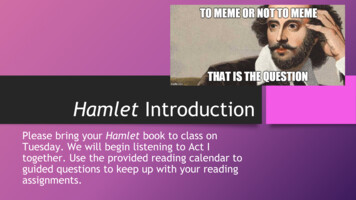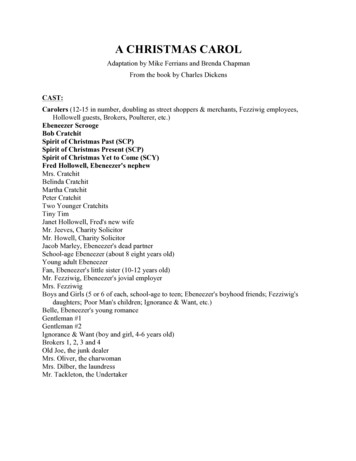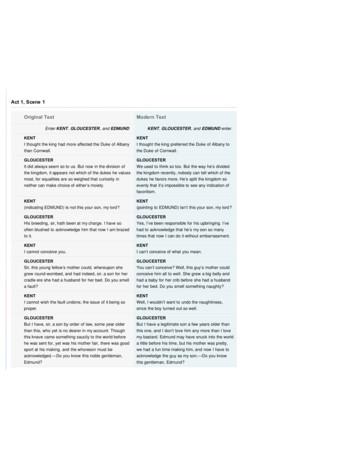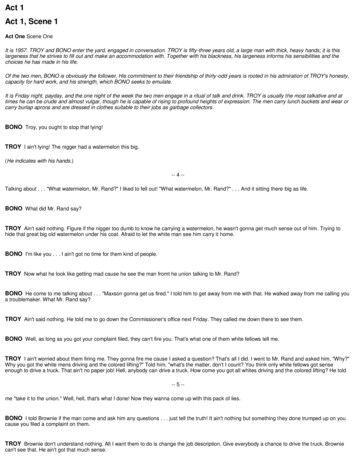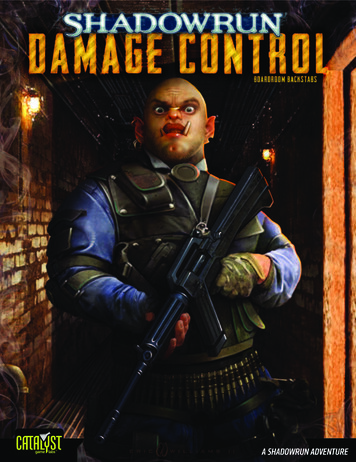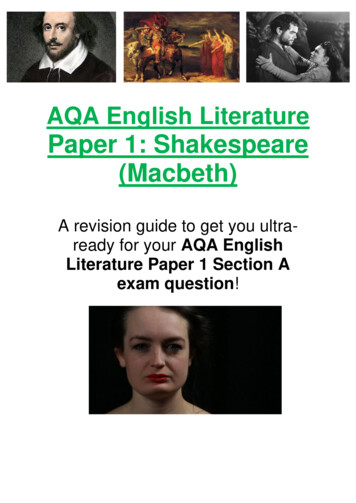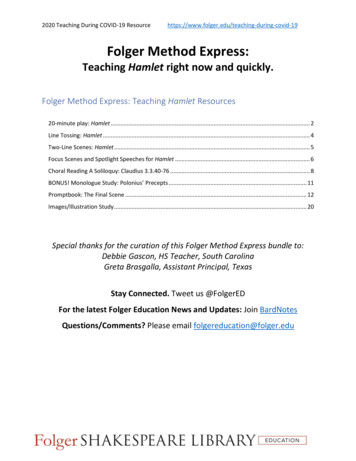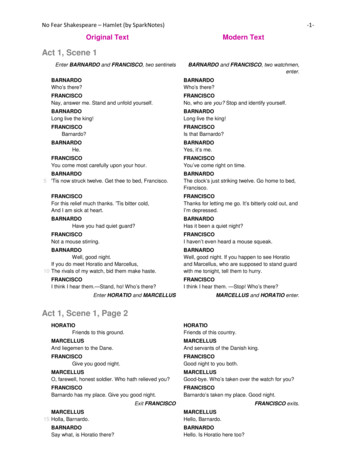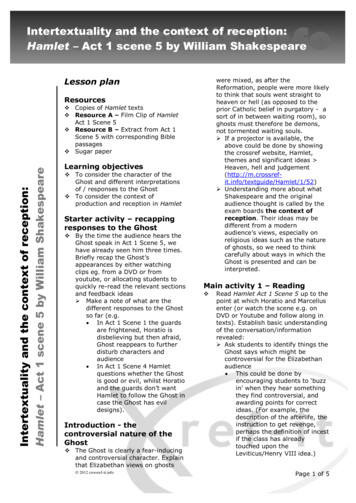
Transcription
Intertextuality and the context of reception:Hamlet – Act 1 scene 5 by William ShakespeareLesson planwere mixed, as after theReformation, people were more likelyto think that souls went straight toheaven or hell (as opposed to theprior Catholic belief in purgatory - asort of in between waiting room), soghosts must therefore be demons,not tormented waiting souls. If a projector is available, theabove could be done by showingthe crossref website, Hamlet,themes and significant ideas Heaven, hell and t/1/52) Understanding more about whatShakespeare and the originalaudience thought is called by theexam boards the context ofreception. Their ideas may bedifferent from a modernaudience’s views, especially onreligious ideas such as the natureof ghosts, so we need to thinkcarefully about ways in which theGhost is presented and can beinterpreted.ResourcesIntertextuality and the context of reception:Hamlet – Act 1 scene 5 by William Shakespeare Copies of Hamlet texts Resource A – Film Clip of HamletAct 1 Scene 5 Resource B – Extract from Act 1Scene 5 with corresponding Biblepassages Sugar paperLearning objectives To consider the character of theGhost and different interpretationsof / responses to the Ghost To consider the context ofproduction and reception in HamletStarter activity – recappingresponses to the Ghost By the time the audience hears theGhost speak in Act 1 Scene 5, wehave already seen him three times.Briefly recap the Ghost’sappearances by either watchingclips eg. from a DVD or fromyoutube, or allocating students toquickly re-read the relevant sectionsand feedback ideas Make a note of what are thedifferent responses to the Ghostso far (e.g.In Act 1 Scene 1 the guardsare frightened, Horatio isdisbelieving but then afraid,Ghost reappears to furtherdisturb characters andaudienceIn Act 1 Scene 4 Hamletquestions whether the Ghostis good or evil, whilst Horatioand the guards don’t wantHamlet to follow the Ghost incase the Ghost has evildesigns).Introduction - thecontroversial nature of theGhost The Ghost is clearly a fear-inducingand controversial character. Explainthat Elizabethan views on ghosts 2012 crossref-it.infoMain activity 1 – Reading Read Hamlet Act 1 Scene 5 up to thepoint at which Horatio and Marcellusenter (or watch the scene e.g. onDVD or Youtube and follow along intexts). Establish basic understandingof the conversation/informationrevealed: Ask students to identify things theGhost says which might becontroversial for the ElizabethanaudienceThis could be done byencouraging students to ‘buzzin’ when they hear somethingthey find controversial, andawarding points for correctideas. (For example, thedescription of the afterlife, theinstruction to get revenge,perhaps the definition of incestif the class has alreadytouched upon theLeviticus/Henry VIII idea.)Page 1 of 5
Intertextuality and the context of reception:Hamlet – Act 1 scene 5 by William ShakespeareHighlight and annotate text withideas.Intertextuality and the context of reception:Hamlet – Act 1 scene 5 by William ShakespeareMain activity 2 – using theBible to consider context ofproduction and reception Explain that many things that theGhost says make reference to ideasin the Bible, which again means theoriginal audience may haveinterpreted them differently fromthe way a modern audience does. Watch the film clip [ResourceA] Divide students into small groupsand give out extracts from Act 1Scene 5 with corresponding Biblepassages and discussion questions.[Resource B]These could be mixed abilitygroups, using higher abilitystudents as leaders to guidethe discussion Students read the Bible passagesand use the discussion questionsas prompts to consider thecontext of production (the ideasof the Elizabethans) and to addto annotations on their texts Feedback ideas/any questionsand mop up any problems. Allow two minutes per questionbefore group moves on to nextpiece of sugar paper and addsideas. Then another two minutesbefore moving on to third andfinal piece/questionStick sugar paper up at front ofclass so students can read allresponses.Homework Students write a page of analysis,looking closely at the Ghost’s speechand considering why he was such acontroversial and powerful characterfor the Elizabethan audience Students should try to include atleast two Bible references.Plenary – brainstormingcarousel and reflections Divide class into three groups with agroup leader and sugar paper.Assign the following tasks, one pergroup:1. What have we learnt aboutpossible different responsesto and interpretations of theGhost?2. What have we learnt aboutthe context of production andreception in terms ofunderstanding Hamlet?3. What have we learnt aboutthe way in which the Biblecan help us to understandliterature? 2012 crossref-it.infoPage 2 of 5
Intertextuality and the context of reception:Hamlet – Act 1 scene 5 by William ShakespeareResourcesResource A – http://www.crossref-it.info/articles/466/Hamlet- -Act-1,-scene-5Resource BHamlet Act 1 scene 5Intertextuality and the context of reception:Hamlet – Act 1 scene 5 by William ShakespeareHAMLETSpeak; I am bound to hear.GhostSo art thou to revenge, when thou shalt hear.Romans 12: 19 avenge not yourselves, but rather give place unto wrath: for it iswritten, Vengeance is mine; I will repay, saith the Lord. Discuss: Why would the Eizabethan audience have found the Ghost’s instructionshocking and dangerous?GhostI am thy father's spirit,Doom'd for a certain term to walk the night,And for the day confined to fast in fires If thou didst ever thy dear father love-Revenge his foul and most unnatural murder.Genesis 4:8-9 8And Cain rose up against Abel his brother, and slew him. 9Andthe LORD said unto Cain, ‘Where is Abel thy brother?’And he said, ‘I know not: Am I my brother's keeper?’ Discuss: Why would Claudius’ murder of King Hamlet seem more controversial toan Elizabethan audience than to a modern audience?HAMLETMurder!GhostMurder most foul, as in the best it is;But this most foul, strange and unnatural.HAMLETHaste me to know't 2012 crossref-it.infoPage 3 of 5
Intertextuality and the context of reception:Hamlet – Act 1 scene 5 by William ShakespeareGhostNow, Hamlet, hear:'Tis given out that, sleeping in my orchard,A serpent stung me;Genesis 3:1 1Now the serpent was more subtil than any beast of the field whichthe LORD God had made.Intertextuality and the context of reception:Hamlet – Act 1 scene 5 by William Shakespeare Discuss: How does King Hamlet’s description of Claudius make him sound so craftyand evil to the original audience?so the whole ear of DenmarkIs by a forged process of my deathRankly abused: but know, thou noble youth,The serpent that did sting thy father's lifeNow wears his crown.HAMLETO my prophetic soul! My uncle!GhostAy, that incestuous, that adulterate beast,With witchcraft of his wit, with traitorous gifts,-O wicked wit and gifts, that have the powerSo to seduce!--won to his shameful lustThe will of my most seeming-virtuous queen Leviticus 20:21 21And if a man shall take his brother's wife, it is an uncleanthing: he hath uncovered his brother's nakedness; they shall be childless. Discuss: Why would Claudius and Gertrude’s relationship be so shocking to anElizabethan audience?Brief let me be. Sleeping within my orchard,My custom always of the afternoon,Upon my secure hour thy uncle stole,With juice of cursed hebenon in a vial,And in the porches of my ears did pourThe leperous distilment Genesis 3:14 14And the LORD God said unto the serpent, Because thou hast donethis, thou art cursed ; upon thy belly shalt thou go, and dust shalt thou eat allthe days of thy life: 2012 crossref-it.infoPage 4 of 5
Intertextuality and the context of reception:Hamlet – Act 1 scene 5 by William ShakespeareIntertextuality and the context of reception:Hamlet – Act 1 scene 5 by William Shakespeare Discuss: What impressions would the Elizabethan audience have formed ofClaudius?Thus was I, sleeping, by a brother's handOf life, of crown, of queen, at once dispatch'd:Cut off even in the blossoms of my sin,Unhousel'd, disappointed, unanel'd,No reckoning made, but sent to my accountWith all my imperfections on my head:O, horrible! O, horrible! most horrible!.1 John 1:9 9If we confess our sins, he is faithful and just to forgive us our sins,and to cleanse us from all unrighteousness.Psalm 32:2 2 Blessed are those whose sin the LORD does not count againstthem Discuss: Why is it so terrifying for the original audience that King Hamlet was notgiven an opportunity to repent of his sins before he died?But, howsoever thou pursuest this act,Taint not thy mind, nor let thy soul contriveAgainst thy mother aught: leave her to heavenAnd to those thorns that in her bosom lodge,To prick and sting her.2 Corinthians 12:7 There was given to me a thorn in the flesh, the messenger ofSatan to buffet me Discuss: According to the Bible passage to which the Ghost alludes, what shouldGertrude’s godly response be? Why is this ironic?Fare thee well at once! Adieu, adieu! Hamlet, remember me.Exit 2012 crossref-it.infoPage 5 of 5
Hamlet – Act 1 scene 5 by William Shakespeare Intertextuality and the context of reception: Hamlet – Act 1 scene 5 thing: he hath uncovered his bro by William Shakespeare so the whole ear of Denmark Is by a forged pro Rankly abused: but know, thou noble youth, The serpent that did sting thy father's life
